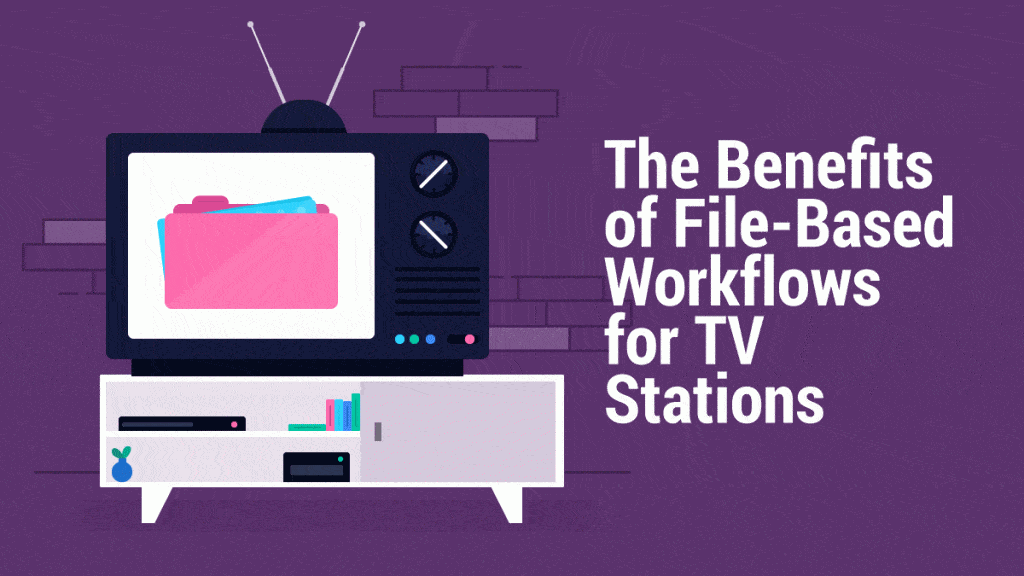The Benefits of File-based Workflows for TV Stations
The recent boom in mobile device usage has changed the way television stations can deliver content. In fact, 87% of television consumers watch long-form

The recent boom in mobile device usage has changed the way television stations can deliver content. In fact, 87% of television consumers watch long-form video on mobile devices. Broadcasts now happen anywhere, anytime thanks to online streaming. For TV stations, many of whom still utilize tape versus file-based workflows, this can make keeping up a challenge. The amount of time each department puts into editing tape, to revision, to meeting industry regulations is immense and maintaining a high level of efficiency while still using outdated technology isn’t easy. The advent of file-based cameras means there’s now the option to go digital rather than use tape when creating content for a television broadcast. However, despite the challenges of making this transition, adopting a file-based workflow can help you keep your competitive edge.
File-based workflows save you time
Although tape is a great medium for when technology fails, it’s not the fastest, or even the most economic choice out there. According to Amazon, “Even when the consumer market began to go tapeless over ten years ago, the television industry retained tape because of its resilience.” But, nowadays, with HD being the standard and more and more file-based digital cameras available on the market than ever before, the reasons for going tapeless are growing. First and foremost, you save time. With tape, content exists on a desk or a shelf in a physical medium and content that is unmarked sometimes goes missing. Even if you do have a great organization method for your physical tapes, the storage space alone is a needless drain on finances. Why put things in a closet when you can put them in the cloud and access them anywhere, anytime just like the consumers you create for? Not to mention, with file-based workflows you can edit faster than ever before and better meet government regulations.
File-based workflows make editing easier
When using a file-based workflow, you can utilize metadata like time stamps and descriptions to mark for editing, thereby saving your team the time it takes to first find the physical tapes, and then sort through each reel to find the appropriate scenes. Although the transition from tape to file-based practices might be costly initially, especially when buying different equipment and software, in the long run, you’ll save money in places you never thought possible. For example, integrating caption files rather than hiring people to do live captioning. When you have a caption in a file format, you can also use timestamps to mark footage for repurposing if a segment needs to air at a later date, or for simple revision of the caption content.
File-based workflows help you meet regulations
In an industry that grows and changes as fast as the television industry, you’ll always have new standards and regulations to adhere to if you want to stay in business. Using a file-based workflow makes it easy to stay on top of things like the 21st Century Communications and Video Accessibility Act in 2010, which President Obama put into effect as a means of creating accessibility for the hard of hearing and other populations that need captions in their everyday lives. It’s important to include captions to meet these ethical standards and keep your company out of trouble and with a file-based workflow, you can create, integrate, edit, and reuse captions by outsourcing someone rather than hiring at an hourly rate.
Streamlining your workflow for more efficiency helps you stay on top of an ever-evolving industry where the bottom line is time, and time is money. Although the switch to file-based or automated workflows can be scary and possibly costly in the beginning, the potential for your content after going tapeless is huge. The user-friendliness alone is an outstanding benefit, and you can always come back to tape in case of emergencies, because as we know: the show must go on.
Heading
Heading 1
Heading 2
Heading 3
Heading 4
Heading 5
Heading 6
Lorem ipsum dolor sit amet, consectetur adipiscing elit, sed do eiusmod tempor incididunt ut labore et dolore magna aliqua. Ut enim ad minim veniam, quis nostrud exercitation ullamco laboris nisi ut aliquip ex ea commodo consequat. Duis aute irure dolor in reprehenderit in voluptate velit esse cillum dolore eu fugiat nulla pariatur.
Block quote
Ordered list
- Item 1
- Item 2
- Item 3
Unordered list
- Item A
- Item B
- Item C
Bold text
Emphasis
Superscript
Subscript

Subscribe to The Rev Blog
Sign up to get Rev content delivered straight to your inbox.




